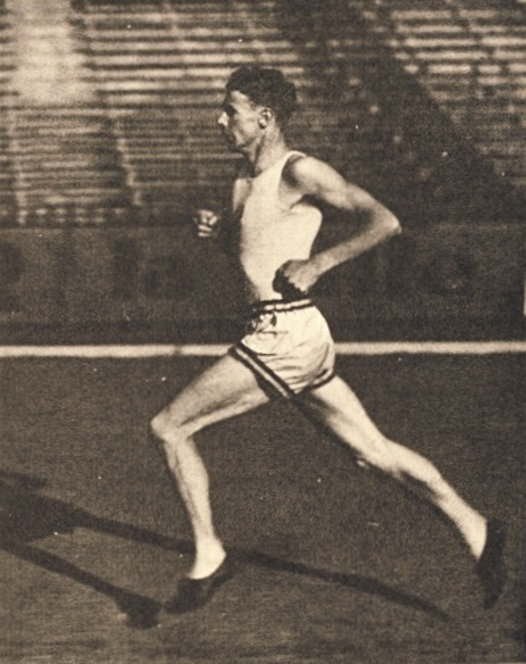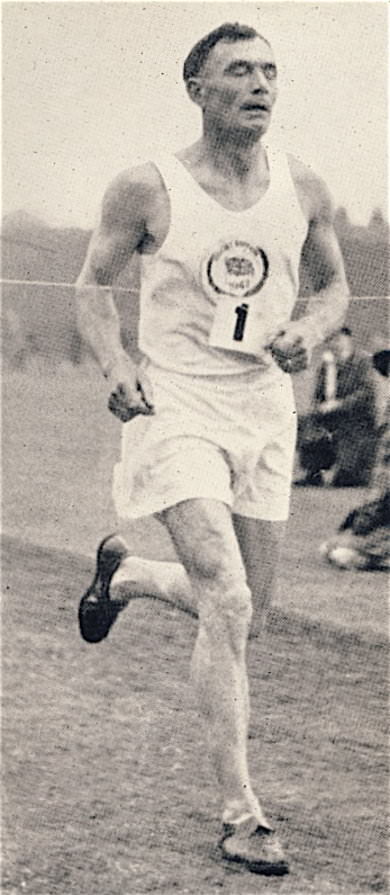Latest from Bob Phillips
In the wake of “The Gateshead Clipper”, Jack Potts, an overlooked Olympic hero Jack Potts, fourth from right, in the winning English cross-country team (Paris, 1935) There was a time, back in the days of amateurism, when some British athletes of real international class missed out on the Olympic Games because they could not afford to lose their income while they were away from work. Now, in this age of rabid professionalism, the selectors choose only to send those competitors who they think could win medals in the belief that the greater the number of medals the more generous will be central funding. Other athletes not so highly thought of are denied their big-time opportunity, even when the necessary finance is available. No thought seems to be given to the idea that young and promising athletes not yet ready to challenge the very best would benefit from the experience of going to a Games, and would do rather better next time round.
Paul Martin: The Good Companion
The Toil, the Tactics, the Triumphs of the Track. Paul Martin, “The Good Companion” Hundredths of seconds decide races, and in the bygone age before such precision timing came into widespread and then universal use tenths of seconds were equally vital. Numerous instances can be quoted of titles won and lost by such a narrow margin, and in an Olympic context early classic examples can even be found in as many as three track finals in middle-distance and long-distance events at the 1912 Games in Stockholm, where the close-run winners were James Meredith, of the USA, at 800 metres; Arnold Jackson, of Great Britain, at 1500 metres; and Johan Kolehmainen, of Finland, at 5000 metres.
Jules Ladomègue: Julot, the French Idol
Julot, the French idol. “Above all of us others”, said Nurmi The life of Jules Ladoumègue Author’s note: John Cobley’s profile of Jules Ladoumègue on this website covers his competitive career in admirable detail, and this article is intended to complement that. Living in France, I can hopefully bring a further perspective to the contribution made to French athletics by Ladoumègue, with whom all subsequent middle-distance record-breakers from that country are still compared.
How George Bonhag Won his Odd Gold Medal
“Going along at a merciless chip”. How George Bonhag Won his Odd Olympic GoldGeorge Bonhag became the leading American distance-runner of the early years of the 20th Century, and it seems that, somewhat surprisingly, he had a British Army officer to thank for that. Bonhag went to the 1906 Olympic Games in Athens and did not do quite as well as might have been hoped for in his favoured events – 4th in the 5 miles and 6th in the 1500 metres. Then, bizarrely, he entered the 1500 metres walk on impulse the next day and won after the first two competitors to finish were disqualified.
Profile
"A bit of a novelty in those days." Who was the first Afro-American to break four minutes for the mile?
27th April 2018
“A bit of a novelty in those days”. Who was the first Afro-American to break four minutes for the mile?There are now more than 1,500 sub-four-minute milers, and so the names of Reggie McAfee and Tommy Fulton are just a couple among many which don’t immediately strike a chord. Yet within a lapse of time of only a few weeks 45 years ago they made a significant contribution to miling history. McAfee and Fulton were both Afro-Americans, and McAfee is the first US-born Afro-American to have broken four minutes for the mile, with 3:59.3 on 21 April 1973, which he improved to 3:57.8 three weeks later, and this latter time was equaled by Fulton in the most unlikely circumstances on 25 May.
A century Ago in War-time: How Athletics Survived and a Swedish Runner Prospered
“You Can’t Out-run a Bullet”. A Century Ago in War-time: How Athletics Survived and a Swedish Runner Prospered “Don’t you know, there’s a war on ?” It would be natural to assume that athletics was on hold a century ago. The battle-fronts had been set remorselessly in Flanders fields since 1914, and in April of 1917 President Woodrow Wilson won a 74-to-nil vote of confidence from Congress to bring the USA into the conflict. Mere sport was bound to suffer when hundreds of thousands of able-bodied men in uniform were being slaughtered, but the story is rather more complicated than that.
A Re-evaluation of the Career of Sin Kim Dan
A Re-evaluation of the Career of Sin Kim DanSuddenly there is a sound. “Ooosh ! Ooosh !” The “superwoman” can be beaten Mysterious. The same description has been used by both the pre-eminent writers, Robert Parienté and Roberto Quercetani, in their comprehensive histories of athletics regarding the exploits of an athlete known to them as Sin Kim Dan but now referred to, presumably in the light of heightened linguistic awareness, as Shin Gheum Dan. She ran 51.2 for 400 metres and 1:58.0 for 800 metres during September and October of 1964 in her home town of Pyongyang, in North Korea (more correctly, the People’s Republic of Korea), and neither performance was ever ratified. The official World records then stood at 51.9 and 2:01.2.
A Record-breaking Track Career Begins Under the Eyes of the Nazi Invaders
A Record-breaking Track Career Begins Under the Eyes of the Nazi InvadersEuropean middle-distance running during the World War II yearsSwedish runners, benefiting hugely from their country’s neutrality, dominated the middle-distance track events during the years of World War II, as is well known, and the great duo of Hägg and Andersson set 21 World records between them from 1500 to 5000 metres. Neither of them, though, was fast enough to add the 800 metres to their accomplishments. The World record for that event of 1:46.6 would, in any case, remain out of reach to all and sundry for another decade after peace was declared, and the fastest man in the event in the latter war years came, surprisingly, from another country with a much less well-established athletics tradition than its Scandinavian neighbour across the straits that led into the Baltic Sea..
A Vision that Paved the Way to Vaporfly
A vision that Paved the Way to VaporflyHigh-grade running-shoe technology is no new phenomenon The current controversy over Nike’s Vaporfly road-running shoe is merely a reminder that footwear fussing and feuding have been going on in track & field athletics for much more than a century. The Finnish manufacturers, Karhu, had been founded in 1916, and enterprisingly produced a distinctive all-white pair of running-spikes which Paavo Nurmi effectively displayed in his gold-medal triumphs at the 1924 Olympic Games, but it was during the Melbourne Games of 1956 that the contest between rival companies to persuade the champions in their choice of brands really began to be waged in earnest. The term “marketing” wasn’t in common use in those days, but the concept had nevertheless by then invaded the cinder-tracks of the World.
See all Profile articles
History

184 years of talking – Parrot fashion – about someone running a four-minute mileby Bob Phillips When I was researching a book I wrote to mark the 50th anniversary in 2004 of the first sub-four-minute mile I became intrigued by the ”near-misses” and the “might-have-been” – the performances by athletes who could perhaps have preceded Roger Bannister by a few years, or even more, had they been given the right opportunity. There are a surprisingly large number of them, and I came to the conclusion, for example, that not nearly enough credit had been given to the fastest mile run in the years before World War II. Contrary to what you might suppose, that was not the official World record of 4:06.8 by Great Britain’s Sydney Wooderson in 1937 but the 4:04.4 indoors by the USA’s Glenn Cunningham the following year.
Early marathon running - the British and Irish influence
Los Angeles and Paris will bid on 13 September to stage the 2024 Olympics. The first Games that were held in Paris, in 1900, were prolonged and often chaotic – in particular, the marathon, which was to be highly influenced in its formative years by British & Irish involvement. Pandemonium in Paris. “Preposterous”, says the perplexed Mr Poolby Bob Phillips The marathon race at the first Modern Olympic Games of 1896 in Athens was a rip-roaring success, and the main reason was that it was won by a Greek, accompanied for the last few yards by royalty, no less, to the immense pleasure of the 40,000 or so onlookers packed into the stadium and many thousands more on the surrounding hill-sides. The home victory was certainly helped by the fact that the only competitors who had any experience of marathon-running were the Greeks themselves, who had qualified via two trial races, and a lone Hungarian, whose athletics administrators had also been sensible enough to stage their own eliminator to see if any of their countrymen could last the distance.

Why Is the Marathon 26 Miles, 385 Yards Long?
We all know that the marathon is 26 miles 385 yards. But why? Whose idea was it?by Bob Phillips Pheidippides didn’t do it. Or if he did, the Ancient Greek press corps were a bit slow on the uptake, and there could only have been a blithe disregard for any sort of reasonable topicality among the scribes of the day. Treating deadlines with disdain, one of the most widely read columnists of 2,400 years or so ago, Herodotus, only picked up on the story some three or four decades later. Plutarch – even more renowned among his avid readership – waited half-a-millenium before putting a pen to paper, or more precisely a split reed to papyrus/ Maybe he was short of anything newsworthy that week and so revived a vaguely remembered myth instead. Even in the 1st Century A.D. when Plutarch was scribbling away (or should that be “scratching” away?), publicity for Greek war messengers was still a sensitive subject because they had often been suspected of being deserters.